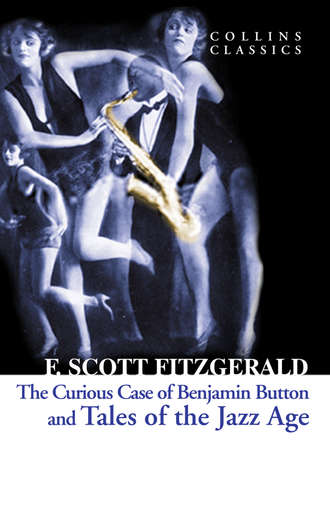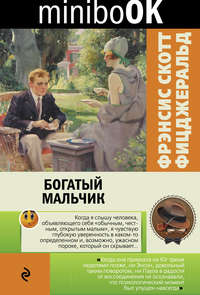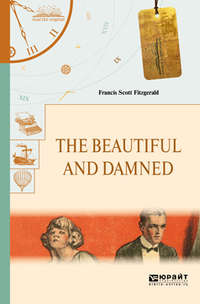
Полная версия
Tales of the Jazz Age

TALES OF THE JAZZ AGE
F. Scott Fitzgerald

History of Collins
In 1819, millworker William Collins from Glasgow, Scotland, set up a company for printing and publishing pamphlets, sermons, hymn books, and prayer books. That company was Collins and was to mark the birth of HarperCollins Publishers as we know it today. The long tradition of Collins dictionary publishing can be traced back to the first dictionary William published in 1824, Greek and English Lexicon. Indeed, from 1840 onwards, he began to produce illustrated dictionaries and even obtained a licence to print and publish the Bible.
Soon after, William published the first Collins novel, Ready Reckoner; however, it was the time of the Long Depression, where harvests were poor, prices were high, potato crops had failed, and violence was erupting in Europe. As a result, many factories across the country were forced to close down and William chose to retire in 1846, partly due to the hardships he was facing.
Aged 30, William’s son, William II, took over the business. A keen humanitarian with a warm heart and a generous spirit, William II was truly “Victorian” in his outlook. He introduced new, up-to-date steam presses and published affordable editions of Shakespeare’s works and The Pilgrim’s Progress, making them available to the masses for the first time. A new demand for educational books meant that success came with the publication of travel books, scientific books, encyclopedias, and dictionaries. This demand to be educated led to the later publication of atlases, and Collins also held the monopoly on scripture writing at the time.
In the 1860s Collins began to expand and diversify and the idea of “books for the millions” was developed. Affordable editions of classical literature were published, and in 1903 Collins introduced 10 titles in their Collins Handy Illustrated Pocket Novels. These proved so popular that a few years later this had increased to an output of 50 volumes, selling nearly half a million in their year of publication. In the same year, The Everyman’s Library was also instituted, with the idea of publishing an affordable library of the most important classical works, biographies, religious and philosophical treatments, plays, poems, travel, and adventure. This series eclipsed all competition at the time, and the introduction of paperback books in the 1950s helped to open that market and marked a high point in the industry.
HarperCollins is and has always been a champion of the classics, and the current Collins Classics series follows in this tradition—publishing classical literature that is affordable and available to all. Beautifully packaged, highly collectible, and intended to be reread and enjoyed at every opportunity.
Life & Times
The Jazz Age
There can be few novels as divisive as F. Scott Fitzgerald’s The Great Gatsby in terms of people’s opinion of its literary worth. It registered disappointing sales upon its publication in 1925, which led to Fitzgerald slipping into obscurity despite his having established a reasonable reputation with earlier books. Following his death, in 1940, the book was included on a list of titles to be provided free to U.S. service men and women fighting in World War II. This meant that 150,000 copies began circulating through the armed forces until the book became familiar to overseas Americans. As a result, it had inadvertently worked its way into the American psyche and won favor where otherwise it would have been forgotten.
The story itself is essentially about the moral decay that ensued in America during the 1920s. Although other countries had class divisions, the U.S. had the equivalent of an upper class in the form of patricians, or members of long-established wealthy families. These New World aristocrats lorded themselves over other people and spent much of their lives partying their way through the “Jazz Age.” In addition, 1920 had seen the prohibition of alcohol, with the result that organized criminals found a way to make good money by bootlegging, or illegally selling liquor. When both of these groups came together, they formed a social order of dilettantism—people who assumed and cultivated pretensions of sophistication. The story of The Great Gatsby spirals into tragedy as the book progresses with a succession of events—manslaughter, murder, and then suicide; tragedy that seems all the more horrific in contrast to the spirited and frothy excesses that have come before.
There is more to the popularity of the novel than its installation into the favor of the U.S. literati by proxy—it’s a book that is representative of an era. In truth, most people had little or no direct involvement with the kinds of people described in the book, but it was a subculture that was perceived as glamorous so it caught the public imagination. In the same way that the 1960s only really happened in the heart of Western cities, so the 1920s only really happened in affluent mansions and areas of the U.S. In fact, it was this collision of subcultures, the wealthy and excessive nature of the elite set against the “average Joe,” that gave the book its potency. In Fitzgerald’s book, Myrtle, the wife of a lowly garage owner, gets seduced by the dilettante lifestyle and starts an affair with the monied Tom Buchanan, leading to tragedy for both her and her husband.
The Great Gatsby appeals because the reader enjoys voyeuristically peering in to view the lives of those who are ridiculed as being exotic, foolish, and beguiled and is grateful not to be a part of it. There is a moral judgment involved in the process of reading such a story, and Fitzgerald’s work can be compared to that of the British author Thomas Hardy, who takes the same view that people tend to get what they deserve in life and that the real victims are those who get caught up, either by accident or by attraction. In effect, The Great Gatsby is a Hardy-esque novel set in 1920s America as opposed to 19th-century England. There is a definite register of contempt penned by both of these authors, as if to suggest that they have chosen to point the spotlight at those for whom they have little time in real life.
From a historical perspective, the book tells of a bygone age that is part of U.S. history. Prohibition ended in 1933 when the U.S. government realized the irony of the situation. Christian values had led to prohibition in an attempt to sober up society and generate a more virtuous American nation. In reality, people simply made their own moonshine or else bought their illegal alcohol from speakeasies, thereby making felons wealthy enough to control the police. Bribery and corruption were rife, so the conservatives had to concede that prohibition had countered their intuition. Six years later and World War II began, reshuffling priorities and making the United States a wealthy superpower. In the post-war era, America flourished and prospered. It had been unscathed by the war, and many nations had to borrow its money to rebuild their infrastructures.
The Great Gatsby became a curious window into a world that had been and gone—a world where elements of U.S. society had drowned themselves in a moral and ethical sump. It was a warning about what can happen when people become decadent and dishonorable. The novel served as an antithesis to the values and image that clean-cut Americans wanted to promote in the 1950s, as a new generation became the custodians of their proud nation. Iniquity was brushed under the carpet and only allowed to exist in the land of fiction.
Earlier Works
Fitzgerald wrote a number of short stories, which were packed in a single volume entitled Tales of the Jazz Age (1922). The best-known of these shorts is The Curious Case of Benjamin Button, in which the eponymous central character ages in reverse. He is born old and decrepit and then goes through all of the other stages of life until he eventually dies as a newborn baby. What makes the tale most interesting is the juxtaposition between Benjamin and the people with whom he has relationships, because his life is being carried out in the opposite direction to theirs.
A similar device is used in Martin Amis’ Time’s Arrow (1991), except that the whole world is played backward, so that curious concepts are explored, such as doctors causing injuries, instead of healing them. Also, the reader eventually realizes that the central character is an erstwhile Holocaust doctor when his reverse life takes him to a younger age. Of course, this concept of playing with time was first investigated by H. G. Wells in his novel The Time Machine (1895). In this story Wells has the central character existing in real time, but the machine enables him to travel both forward and backward in time.
There are ten other shorts in Tales of the Jazz Age. Some examine the human characteristics that made the Jazz Age what it was, such as the excess, frivolity, vanity, pretensions, and cultural hysteria brought about by the mood following World War I.
Just as the Restoration in England generated a kind of lighthearted optimism after the suppressive atmosphere under the Puritans, so the Jazz Age was a kind of celebration of life after so much death in Europe. It was marked by the popularity of jazz music and an associated dance craze, but would all come to an end in the early1930s with the Great Depression.
Exploring the topic of excess in this collection is the tale A Diamond as Big as the Ritz. In this story, Fitzgerald gives the central character a dilemma to solve. In his quest to become rich, Percy Washington discovers a mountain comprising a single diamond, but he realizes that if he saturates the market with diamonds, they will become commonplace and have no value. Both stories highlight Fitzgerald’s underlying inclination to experiment with intellectual and philosophical concepts in his work. This is largely why he is regarded as a literary writer, rather than merely a teller of tales.
On face value, much of his writing would seem to be amusing comment on his own “Smart Set” lifestyle and aimed at others from the same milieu, but Fitzgerald was an intelligent man with considerable depth to his thinking. It is just that he also knew how to be commercial enough to make money from his writing, which demanded a layer of gloss and polish. His was a world of inherited privilege, inhabited by pseudo-intellectuals and posers. He himself made several trips to Paris and the French Riviera, where he cultivated and honed a lifestyle that went hand in hand with his writing style. He wrote about what he knew, but he injected other elements to facilitate his curiosity about the human condition and give his writing greater literary weight.
Fitzgerald and Hemingway
Fitzgerald was friends with arguably the greatest American writer, Ernest Hemingway. Hemingway encouraged Fitzgerald to pursue his prose with artistic integrity, but grew frustrated with Fitzgerald’s tendency toward making his literature commercial. However, most of Fitzgerald’s novels did not perform that well, so a large part of his income came from magazine work, writing short stories that, by their very nature, had to conform to editorial requirements. Nine years after The Great Gatsby, he had struggled to complete his final novel Tender Is The Night. Unfortunately for Fitzgerald, the book was received with disappointment, and the decline of his writing career continued unabated. In the latter half of the 1930s, he found work developing movie scripts and carried out further commercial writing. By the time of his death, his literary career had died, too.
In hindsight, Fitzgerald’s work is regarded variously, but The Great Gatsby has become the quintessential American classic. Some feel that Fitzgerald’s talent would have been better focused on his novel writing, but fiscal matters always dictated that he continue with his commercial work. However, Hemingway may have been a heavyweight writer but he was certainly not a contented man. For him the praise he garnered for each new book was a fix. When he ran out of ideas, he suffered severe depression and ultimately took his own life with a shotgun. Fitzgerald battled on in a workmanlike manner even when plaudits were a distant memory. Fitzgerald the legendary writer has now outlived Fitzgerald the man several times over.
CONTENTS
Title Page
History of Collins
Life & Times
My Last Flappers
The Jelly-Bean
The Camel’s Back
May Day
Porcelain and Pink
Fantasies
The Diamond as Big as the Ritz
The Curious Case of Benjamin Button
Tarquin of Cheapside
“O Russet Witch!”
Unclassified Masterpieces
The Lees of Happiness
Mr. Icky
Jemina, The Mountain Girl
Classic Literature: Words and Phrases adapted from the Collins English Dictionary
Copyright
About the Publisher
The Jelly-Bean
This is a Southern story, with the scene laid in the small Lily of Tarleton, Georgia. I have a profound affection for Tarleton, but somehow whenever I write a story about it I receive letters from all over the South denouncing me in no uncertain terms. “The Jelly-Bean,” published in “The Metropolitan,” drew its full share of these admonitory notes.
It was written under strange circumstances shortly after my first novel was published, and, moreover, it was the first story in which I had a collaborator. For, finding that I was unable to manage the crap-shooting episode, I turned it over to my wife, who, as a Southern girl, was presumably an expert on the technique and terminology of that great sectional pastime.
I
Jim Powell was a Jelly-bean. Much as I desire to make him an appealing character, I feel that it would be unscrupulous to deceive you on that point. He was a bred-in-the-bone, dyed-in-the-wool, ninety-nine three-quarters per cent Jelly-bean and he grew lazily all during Jelly-bean season, which is every season, down in the land of the Jelly-beans well below the Mason-Dixon line.
Now if you call a Memphis man a Jelly-bean he will quite possibly pull a long sinewy rope from his hip pocket and hang you to a convenient telegraph-pole. If you Call a New Orleans man a Jelly-bean he will probably grin and ask you who is taking your girl to the Mardi Gras ball. The particular Jelly-bean patch which produced the protagonist of this history lies somewhere between the two—a little city of forty thousand that has dozed sleepily for forty thousand years in southern Georgia occasionally stirring in its slumbers and muttering something about a war that took place sometime, somewhere, and that everyone else has forgotten long ago.
Jim was a Jelly-bean. I write that again because it has such a pleasant sound—rather like the beginning of a fairy story—as if Jim were nice. It somehow gives me a picture of him with a round, appetizing face and all sort of leaves and vegetables growing out of his cap. But Jim was long and thin and bent at the waist from stooping over pool-tables, and he was what might have been known in the indiscriminating North as a corner loafer. “Jelly-bean” is the name throughout the undissolved Confederacy for one who spends his life conjugating the verb to idle in the first person singular—I am idling, I have idled, I will idle.
Jim was born in a white house on a green corner, It had four weather-beaten pillars in front and a great amount of lattice-work in the rear that made a cheerful criss-cross background for a flowery sun-drenched lawn. Originally the dwellers in the white house had owned the ground next door and next door to that and next door to that, but this had been so long ago that even Jim’s father, scarcely remembered it. He had, in fact, thought it a matter of so little moment that when he was dying from a pistol wound got in a brawl he neglected even to tell little Jim, who was five years old and miserably frightened. The white house became a boarding-house run by a tight-lipped lady from Macon, whom Jim called Aunt Mamie and detested with all his soul.
He became fifteen, went to high school, wore his hair in black snarls, and was afraid of girls. He hated his home where four women and one old man prolonged an interminable chatter from summer to summer about what lots the Powell place had originally included and what sorts of flowers would be out next. Sometimes the parents of little girls in town, remembering Jim’s mother and fancying a resemblance in the dark eyes and hair, invited him to parties, but parties made him shy and he much preferred sitting on a disconnected axle in Tilly’s Garage, rolling the bones or exploring his mouth endlessly with a long straw. For pocket money, he picked up odd jobs, and it was due to this that he stopped going to parties. At his third party little Marjorie Haight had whispered indiscreetly and within hearing distance that he was a boy who brought the groceries sometimes. So instead of the two-step and polka, Jim had learned to throw, any number he desired on the dice and had listened to spicy tales of all the shootings that had occurred in the surrounding country during the past fifty years.
He became eighteen. The war broke out and he enlisted as a gob and polished brass in the Charleston Navy-yard for a year. Then, by way of variety, he went North and polished brass in the Brooklyn Navy-yard for a year.
When the war was over he came home, He was twenty-one, has trousers were too short and too tight. His buttoned shoes were long and narrow. His tie was an alarming conspiracy of purple and pink marvellously scrolled, and over it were two blue eyes faded like a piece of very good old cloth, long exposed to the sun.
In the twilight of one April evening when a soft gray had drifted down along the cottonfields and over the sultry town, he was a vague figure leaning against a board fence, whistling and gazing at the moon’s rim above the lights of Jackson Street. His mind was working persistently on a problem that had held his attention for an hour. The Jelly-bean had been invited to a party.
Back in the days when all the boys had detested all the girls, Clark Darrow and Jim had sat side by side in school. But, while Jim’s social aspirations had died in the oily air of the garage, Clark had alternately fallen in and out of love, gone to college, taken to drink, given it up, and, in short, become one of the best beaux of the town. Nevertheless Clark and Jim had retained a friendship that, though casual, was perfectly definite. That afternoon Clark’s ancient Ford had slowed up beside Jim, who was on the sidewalk and, out of a clear sky, Clark invited him to a party at the country club. The impulse that made him do this was no stranger than the impulse which made Jim accept. The latter was probably an unconscious ennui, a half-frightened sense of adventure. And now Jim was soberly thinking it over.
He began to sing, drumming his long foot idly on a stone block in the sidewalk till it wobbled up and down in time to the low throaty tune:
“One smile from Home in Jelly-bean town,
Lives Jeanne, the Jelly-bean Queen.
She loves her dice and treats em nice;
No dice would treat her mean.”
He broke off and agitated the sidewalk to a bumpy gallop.
“Daggone!” he muttered, half aloud. They would all be there—the old crowd, the crowd to which, by right of the white house, sold long since, and the portrait of the officer in gray over the mantel, Jim should have belonged. But that crowd had grown up together into a tight little set as gradually as the girls’ dresses had lengthened inch by inch, as definitely as the boys’ trousers had dropped suddenly to their ankles. And to that society of first names and dead puppy loves Jim was an outsider—a running mate of poor whites. Most of the men knew him, condescendingly; he tipped his hat to three or four girls. That was all.
When the dusk had thickened into a blue setting for the moon, he walked through the hot, pleasantly pungent town to Jackson Street. The stores were closing and the last shoppers were drifting homeward, as if borne on the dreamy revolution of a slow merry-go-round. A street-fair farther down a brilliant alley of varicolored booths and contributed a blend of music to the night—an oriental dance on a calliope, a melancholy bugle in front of a freak show, a cheerful rendition of “Back Home in Tennessee” on a hand-organ.
The Jelly-bean stopped in a store and bought a collar. Then he sauntered along toward Soda Sam’s, where he found the usual three or four cars of a summer evening parked in front and the little darkies running back and forth with sundaes and lemonades.
“Hello, Jim.”
It was a voice at his elbow—Joe Ewing sitting in an automobile with Marylyn Wade. Nancy Lamar and a strange man were in the back seat.
The Jelly-bean tipped his hat quickly.
“Hi Ben—” then, after an almost imperceptible pause— “How y’ all?”
Passing, he ambled on toward the garage where he had a room up-stairs. His “How y’all” had been said to Nancy Lamar, to whom he had not spoken in fifteen years.
Nancy had a mouth like a remembered kiss and shadowy eyes and blue-black hair inherited from her mother who had been born in Budapest. Jim passed her often on the street, walking small-boy fashion with her hands in her pockets and he knew that with her inseparable Sally Carrol Hopper she had left a trail of broken hearts from Atlanta to New Orleans.
For a few fleeting moments Jim wished he could dance. Then he laughed and as he reached his door began to sing softly to himself:
“Her Jelly Roll can twist your soul,
Her eyes are big and brown,
She’s the Queen of the Queens of the Jelly-beans—
My Jeanne of Jelly-bean Town.”
II
At nine-thirty, Jim and Clark met in front of Soda Sam’s and started for the Country Club in Clark’s Ford. “Jim,” asked Clark casually, as they rattled through the jasmine-scented night, “how do you keep alive?”
The Jelly-bean paused, considered.
“Well,” he said finally, “I got a room over Tilly’s garage. I help him some with the cars in the afternoon an’ he gives it to me free. Sometimes I drive one of his taxies and pick up a little thataway. I get fed up doin’ that regular though.”
“That all?”
“Well, when there’s a lot of work I help him by the day—Saturdays usually—and then there’s one main source of revenue I don’t generally mention. Maybe you don’t recollect I’m about the champion crap-shooter of this town. They make me shoot from a cup now because once I get the feel of a pair of dice they just roll for me.”
Clark grinned appreciatively.
“I never could learn to set ’em so’s they’d do what I wanted. Wish you’d shoot with Nancy Lamar some day and take all her money away from her. She will roll ’em with the boys and she loses more than her daddy can afford to give her. I happen to know she sold a gold ring last month to pay a debt.”
The Jelly-bean was noncommittal.
“The white house on Elm Street still belong to you?”
Jim shook his head.
“Sold. Got a pretty good price, seein’ it wasn’t in a good part of town no more. Lawyer told me to put it into Liberty bonds. But Aunt Mamie got so she didn’t have no sense, so it takes all the interest to keep her up at Great Farms Sanitarium.











